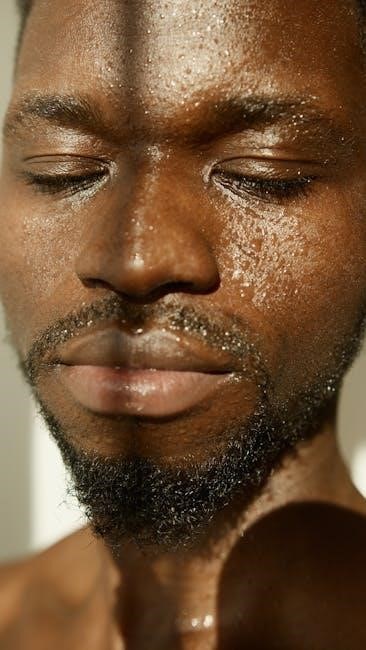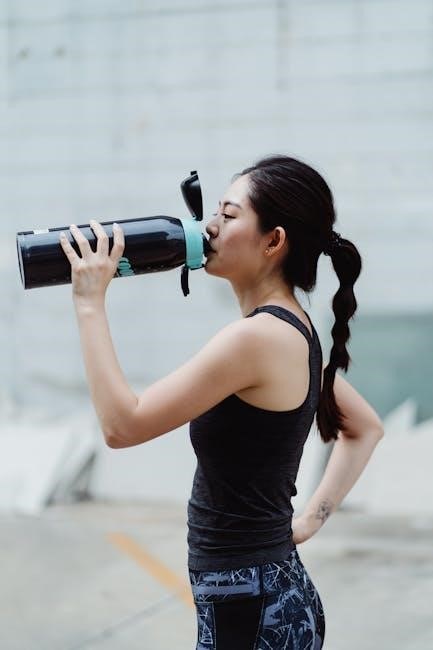Zora Neale Hurston’s Sweat is a powerful short story published in 1926, exploring themes of oppression, resilience, and marital struggle through the protagonist Delia Jones. The narrative vividly portrays the hardships faced by African American women in the rural South, using rich dialect and cultural nuances. Hurston’s work remains a cornerstone of the Harlem Renaissance, offering profound insights into race, gender, and labor. The story’s enduring relevance lies in its unflinching portrayal of survival and dignity amidst adversity.
1.1 Overview of the Short Story
Zora Neale Hurston’s Sweat tells the story of Delia Jones, a hardworking African American wash-woman in rural Florida, and her abusive husband, Sykes. The narrative unfolds on a Sunday night, highlighting Delia’s relentless labor and her struggle for dignity in a oppressive marriage. Sykes’s plan to kill Delia through a snake ultimately backfires, leading to his demise. The story explores themes of domestic abuse, resilience, and the triumph of hard work over laziness.
1.2 Historical Context and Background
Zora Neale Hurston’s Sweat, published in 1926 in the magazine Fire!!, reflects the cultural and social dynamics of African American life during the Harlem Renaissance. Set in rural Florida, the story captures the struggles of African American women, exploring themes of oppression and resilience. Hurston’s use of black vernacular and vivid descriptions of rural life underscores the socio-economic realities of the time, making it a significant work of early 20th-century African American literature.

Themes in “Sweat”
Zora Neale Hurston’s Sweat explores themes of marital abuse, hard work, and resilience. The story highlights the oppressive dynamics between Delia and Sykes, while portraying the struggle for dignity.
2.1 Oppression and Domestic Abuse
Zora Neale Hurston’s Sweat vividly portrays the oppressive relationship between Delia and Sykes Jones. Sykes’s emotional and physical abuse, coupled with Delia’s resilience, highlight the struggles of African American women in patriarchal societies. The story underscores the psychological toll of domestic abuse and the societal norms that perpetuate it, while also celebrating Delia’s quiet strength and survival in the face of oppression.
2.2 Hard Work vs. Laziness
Zora Neale Hurston’s Sweat contrasts Delia’s relentless work ethic with Sykes’s laziness. Delia, a dedicated wash-woman, embodies resilience and determination, while Sykes avoids labor, exploiting her efforts. Their dynamic highlights the clash between productivity and indolence, reflecting broader societal tensions. Hurston uses this dichotomy to critique gender roles and the devaluation of women’s labor, emphasizing the moral and emotional toll of such disparities in their relationship and community.
Characters and Character Development
Delia Jones, the resilient protagonist, embodies strength and determination, while her husband Sykes symbolizes manipulation and laziness. Their contrasting traits drive the narrative’s exploration of power dynamics and moral decay, highlighting Hurston’s nuanced portrayal of human complexity through their evolving relationship.
3.1 Delia Jones: The Protagonist
Delia Jones is the embodiment of resilience and determination. As a wash-woman, she represents the struggles of African American women in the rural South. Her unwavering commitment to her work and independence contrasts sharply with her husband Sykes’s laziness and abuse. Through her character, Hurston highlights the strength and resourcefulness required to survive in a society fraught with oppression and gender inequality. Delia’s journey underscores themes of female empowerment and the quest for dignity in the face of adversity.
Sykes Jones, Delia’s husband, embodies laziness, manipulation, and greed. His disdain for Delia’s hard work and his own lack of ambition fuel the marital conflict. Sykes’s abusive nature and deceitful schemes, including his plan to kill Delia, highlight his role as the antagonist. His character serves to underscore themes of oppression and domestic abuse, ultimately leading to his downfall when Delia outsmarts him in a twist of fate.

Sweat as a Play by Lynn Nottage
3.2 Sykes Jones: The Antagonist
Sykes Jones, Delia’s husband, is a manipulative and lazy man who resents Delia’s hard work. His abusive nature and greed drive the marital conflict, making him the story’s antagonist. Sykes’s disdain for Delia’s labor and his own lack of ambition highlight his oppressive role, ultimately leading to his downfall when Delia outsmarts him in a twist of fate.
4.1 Plot Summary of the Play
Lynn Nottage’s Sweat is a gripping drama set in a factory town, exploring the lives of working-class Americans navigating globalization’s impact. The play follows a group of factory workers in Reading, Pennsylvania, as they face layoffs, personal struggles, and shifting relationships. Tensions rise when one character is promoted, creating conflict and highlighting the fragility of friendships and the harsh realities of economic decline.
4.2 Themes of Globalization and Social Struggles
Lynn Nottage’s Sweat delves into the devastating effects of globalization on a small Pennsylvania town. The play portrays factory layoffs, economic decline, and the erosion of trust among friends. It highlights the struggles of working-class Americans facing identity loss and systemic inequality. Themes of race, class, and survival emerge, capturing the human cost of industrial collapse and the fractured American Dream.

Sweat in Scientific Research
Sweat is a biological sample used in DNA identification and medical studies. Researchers analyze sweat glands to understand genetic disorders and develop diagnostic tools, advancing forensic science.
5.1 Sweat and DNA Identification
Sweat contains DNA traces, making it a valuable biological sample for forensic analysis. Researchers use advanced techniques to extract genetic material from sweat, aiding in criminal investigations and personalized medicine. This non-invasive method enhances DNA profiling accuracy, offering new possibilities in identifying individuals and solving crimes. Sweat-based DNA analysis is a growing field, combining biology and technology for innovative applications.
5.2 Sweat Gland Function in Medical Studies
Sweat gland function is extensively studied in medical research to understand its role in thermoregulation and fluid balance. Researchers analyze sweat composition to diagnose conditions like cystic fibrosis and hyperhidrosis. Non-invasive sweat tests are used to assess genetic disorders, offering insights into metabolic health. This research aids in developing treatments for excessive sweating and improving diagnostic tools for various diseases, highlighting sweat’s significance in medical science.
Sweat in Sports and Fitness
Sweat plays a crucial role in athletic performance by aiding thermoregulation and preventing overheating. Managing sweat through hydration and apparel enhances endurance, ensuring optimal physical health and peak performance.
6.1 The Role of Sweat in Athletic Performance
Sweat is essential for thermoregulation during exercise, preventing overheating by evaporating and cooling the body. Proper hydration maintains sweat efficiency, optimizing physical performance. Excessive sweat can lead to dehydration, reducing endurance. Athletes use sweat-resistant gear to manage moisture, enhancing comfort and focus. Balancing fluid intake and sweat loss is crucial for peak performance and overall health during intense workouts.
6.2 Managing Sweat During Workouts
Effectively managing sweat during workouts enhances comfort and performance. Using sweat-resistant clothing, towels, and bands helps absorb moisture. Staying hydrated is crucial to maintain sweat efficiency and prevent dehydration. Applying antiperspirants or using breathable fabrics can reduce sweat buildup. Proper ventilation and cooling techniques, like cooling towels or fans, also aid in managing sweat, ensuring a more efficient and enjoyable exercise session.

Sweat in Fashion and Apparel
Sweat-resistant clothing and accessories are essential for active lifestyles, protecting fabrics from moisture damage. Designs often feature breathable materials, ensuring comfort and durability during intense workouts or daily activities.
7.1 Sweat-Resistant Clothing and Accessories
Sweat-resistant clothing and accessories are designed to withstand moisture, ensuring comfort and durability. These items often feature technical fabrics with moisture-wicking properties, breathable designs, and antimicrobial treatments. Popular options include sports apparel, activewear, and accessories like headbands, wristbands, and armbands. They are ideal for athletes and individuals with active lifestyles, protecting both the wearer and their gear from sweat damage during workouts or outdoor activities.
7.2 Sweatbands and Their Practical Uses
Sweatbands are versatile accessories designed to absorb moisture, reducing irritation and discomfort during physical activities. Commonly used in sports and workouts, they are made from breathable, moisture-wicking materials like cotton or synthetic fibers. Beyond functionality, sweatbands also serve as fashion statements, with customizable designs. Their practicality extends to everyday use, offering a stylish way to manage sweat while maintaining comfort and hygiene.
Sweat in Cultural and Literary Contexts
Zora Neale Hurston’s Sweat symbolizes resilience and struggle, reflecting the cultural and societal challenges faced by African Americans. The story highlights themes of labor, identity, and survival, making it a powerful representation of the human experience.
8.1 Symbolism of Sweat in Literature
In literature, sweat often symbolizes hard work, sacrifice, and resilience. In Zora Neale Hurston’s Sweat, it represents Delia’s relentless labor and her struggle for survival. The story uses sweat as a metaphor for the physical and emotional toll of oppression, highlighting the enduring strength of African American women in the face of adversity. This motif underscores themes of perseverance and dignity.
8.2 Sweat as a Metaphor for Hard Work and Struggle
Sweat in literature often serves as a powerful metaphor for hard work and struggle, embodying the physical and emotional toll of labor. In Zora Neale Hurston’s Sweat, Delia’s relentless toil and her husband’s indolence contrast sharply, symbolizing the disparity between productive effort and laziness. The story uses sweat to highlight resilience, sacrifice, and the enduring spirit of those who labor tirelessly for survival and dignity.
Sweat, whether in literature, science, or daily life, symbolizes human effort and resilience. Its significance spans cultural, medical, and social contexts, remaining a vital topic in modern discourse and exploration.
9.1 Relevance of “Sweat” in Modern Times
Zora Neale Hurston’s Sweat remains relevant today, as its themes of oppression, resilience, and marital dynamics continue to resonate. The story’s exploration of gender roles and labor aligns with modern discussions on equality and social justice. Additionally, scientific studies on sweat’s role in DNA identification and medical research highlight its practical significance in contemporary times, making Sweat a timeless and multifaceted topic across disciplines.
9.2 Final Thoughts on the Significance of Sweat
Zora Neale Hurston’s Sweat endures as a literary masterpiece, offering profound commentary on race, gender, and labor. Its exploration of resilience and oppression remains universally relevant, while its scientific and cultural connections expand its significance. From its role in literature to its implications in science and sports, sweat embodies the essence of human struggle and achievement, making it a timeless and versatile subject across disciplines.
